Features of growing a leafy hybrid of Redbor f1 cabbage
Redbor F1 cabbage is an exotic representative of hybrid kale varieties. It is distinguished not only by its high taste, but also by its rare beauty - it is often used in landscape design. Due to its frost resistance, curly dark purple leaves look great even under the shelter of snow. Having studied the peculiarities of growing Redbor F1 collard greens, it is not difficult to get your own crop.
The content of the article
- Description of Redbor F1 cabbage hybrid
- Origin and development
- Breeding history
- What is this type and how does it differ from the usual
- Chemical composition, trace elements and vitamins, useful properties
- Application features
- Ripening period and yield
- Disease resistance
- Cold resistance
- Plant characteristic
- For which regions it is best suited and what is the exacting climate
- The main advantages and disadvantages of the Redbor hybrid
- Features of planting and growing
- The nuances of care
- Harvesting and storage
- What can be the difficulties in growing
- Redbor F1 cabbage dishes
- Advice and feedback from experienced gardeners
- Conclusion
Description of Redbor F1 cabbage hybrid
The Redbor F1 hybrid has not yet become widespread among domestic gardeners, but many have already become interested in this culture and are successfully mastering it on their land plots.
Origin and development
In 2000, the late ripening hybrid Redbor F1 was included in the State Register for garden plots, home gardens and small farms. The culture was bred by Dutch breeders from wild species, from which unpretentiousness and resistance to unfavorable natural and climatic conditions were inherited.
The “ancestor” of Redbor's leaves were smooth, monochromatic and with an even edge, but in the process of selection work their edges became corrugated, resembling a fringe. The leaves are purple and exotic.
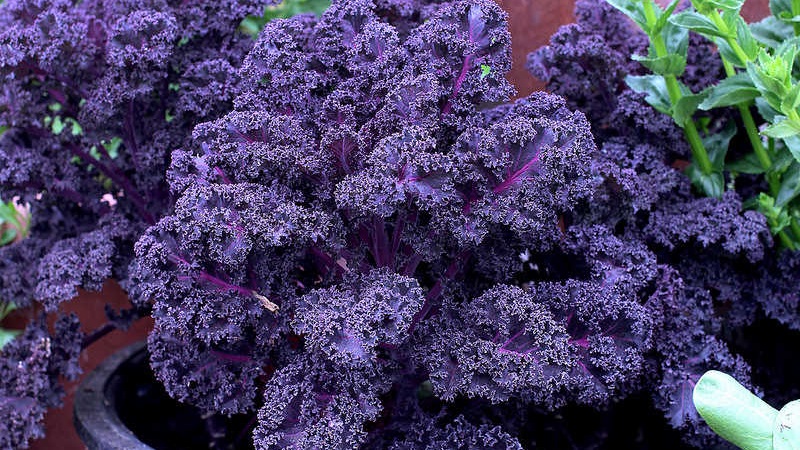
Breeding history
The practical application of the results achieved (frost resistance, high yield, early maturity) by crossing the two varieties began at the beginning of the 20th century. Redbor F1 is among the most successful modern hybrids.
Now the culture is widely used in countries with developed agriculture.
What is this type and how does it differ from the usual
Redbor differs from other varieties and hybrids of cabbage in that it does not form a head of cabbage... The plant looks like a loose rosette of leaves laced along the edge, rather thin, but juicy, purple in color. Grows in a bush 1.5 m high.
The plant is biennial, yields a harvest in the second year after planting... It has another unusual feature - the active growth of lateral leaves, which makes it possible to repeatedly harvest.
Chemical composition, trace elements and vitamins, useful properties
Kale is significantly ahead of its "relatives" in the content of nutrients... In terms of protein content, it is an excellent alternative to meat, and in terms of the content of omega-3 fatty acid, it is an excellent alternative to fish products. In addition to 25 essential amino acids, 100 g of the leaves of the crop are rich in vitamins and minerals.
Vitamins:
- A - 681 mcg,
- B - 0.7 mg
- PP - 0.5 mg,
- C - 41 mg,
- B-carotene - 8.173 mg.
Minerals:
- potassium - 228 mg,
- magnesium - 18 mg,
- phosphorus - 28 mg,
- zinc - 0.24 mg,
- selenium - 0.9 mcg,
- calcium - 72 mg (contained in the same amount as in dairy products).
Redbor contains antioxidants - glucosinolate and sulforaphane, which inhibit the development of cancer cells.
Cabbage improves the functioning of the digestive system and prevents constipation, strengthens the immune system, prevents bone loss, improves vision, regulates blood glucose levels, etc.
Application features
Luxurious curly leaves of Redbor have attracted the attention of designers from different countries, therefore, the hybrid is successfully used in landscape gardening, especially in China and Japan.
Cabbage is stewed, boiled, consumed raw, used in medicine and cosmetology.
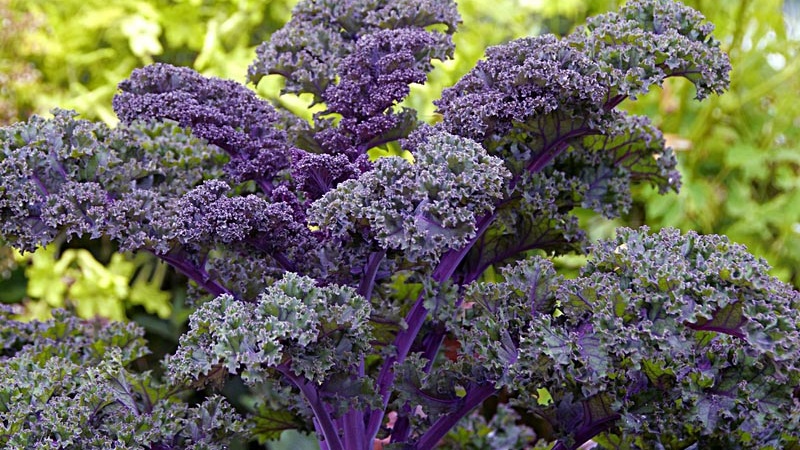
Ripening period and yield
Redbor bushes grow until the end of summer, and the harvest ripens in 3 months after emergence (the height of the leaves of the rosette at this time is 20-25 cm).
The culture gives high yields - about 3-7 kg / m² of succulent leaves, regardless of weather conditions.
Disease resistance
Cabbage has a strong immunity to typical diseases and insects - keela and cabbage fly are not terrible for the plant, but it not insured against the invasion of other pests:
- aphids;
- cruciferous fleas;
- cabbage scoops;
- leaf beetles.
Redbor F1 cabbage resistance increase with the help of "Immunocytofit", sodium humate.
Interesting on the site:
Brussels sprouts: growing technology
Cold resistance
An important feature of the hybrid is its amazing resistance to low temperatures. (down to -18 ° C). After the first frost, the leaves become even more juicy and soft, without losing not only decorativeness, but also useful properties. Under the influence of low temperatures, they acquire a more intense color and a pleasant sweetish aftertaste.
Plant characteristic
Redbor is a member of the Cruciferae family and is considered one of the most popular hybrids.... This beautiful emerald purple vegetable has lush leaves and a palm tree shape. Head of cabbage is not formed. Sometimes the plant height reaches 150 cm, belongs to the late maturing group.
Attention! The bitterness typical of cruciferous crops is not observed. Vegetable dishes are tender and tasty.
For which regions it is best suited and what is the exacting climate
Since the hybrid is unpretentious and resistant to harsh weather and climatic conditions, it is grown throughout the country - from the Far East to Arkhangelsk, that is, almost everywhere, with the exception of areas with an arctic climate. It painlessly tolerates high temperatures up to + 30 ° С and low temperatures down to -18 ° С, so it makes no sense to create special conditions and grow it in greenhouses or greenhouses.
The main advantages and disadvantages of the Redbor hybrid
Cabbage effectively decorates the beds, flower beds, and has other advantages:
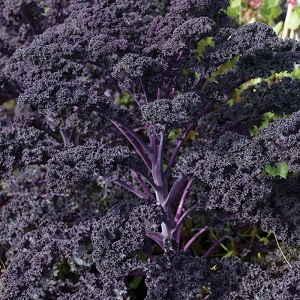 adapts to different cultivation conditions;
adapts to different cultivation conditions;- pleasant and unusual taste;
- tolerates light shading;
- resistant to shooting;
- suitable for cultivation in different soil conditions throughout the agricultural territory of the Russian Federation;
- not afraid of low temperatures.
The disadvantages of a hybrid include:
- short shelf life;
- the risk of being hit by pests.
What is the difference from other varieties and hybrids
This cruciferous variety is a versatile vegetable that lacks a head of cabbage.... It also differs in the presence of juicy stalks used in cooking due to its pleasant taste. In other hybrids, they are tough and unsuitable for consumption.
Also, Redbor significantly overtakes its cabbage "relatives" in the content of nutrients.
Features of planting and growing
Agricultural technology is almost the same from the cultivation of common varieties.
Preparing for landing
As sprawling plant, under suitable conditions reaching 2 m in diameter, an appropriate landing area is allocated for it.
Seed preparation
For better germination, they are soaked for 20 minutes. in warm water or treated with "Epin", "Agat". Then for 2-3 days they are placed in a wet cloth and left in a warm place for germination.
Seedling preparation
The hatched seeds are planted in peat pots small diameter or plastic cups filled with soil mixture. Grains germinate within 5-7 days, and seedlings are suitable for planting in the ground 35-45 days after emergence.
How to make a seedless plant
This method involves sowing seeds directly into the ground.... When choosing a site for sowing, take into account that Redbor, like other cabbage, prefers sunny places. Even a small shadow affects the growing season of the crop: the leaves become smaller, coarser, the bright color fades, which will further affect the yield of the vegetable.
Ground requirements
Although kale is undemanding to the properties of the soil, gardeners note that sockets develop much better in soil with such characteristics:
- medium acidity;
- the presence of feeding with humus and manure;
- good drainage layer (sand, gravel).
On acidic and poor soils, Redbor cabbage grows bitter, and its leaves are small. Therefore, when digging, slaked lime or dolomite flour is mandatory.
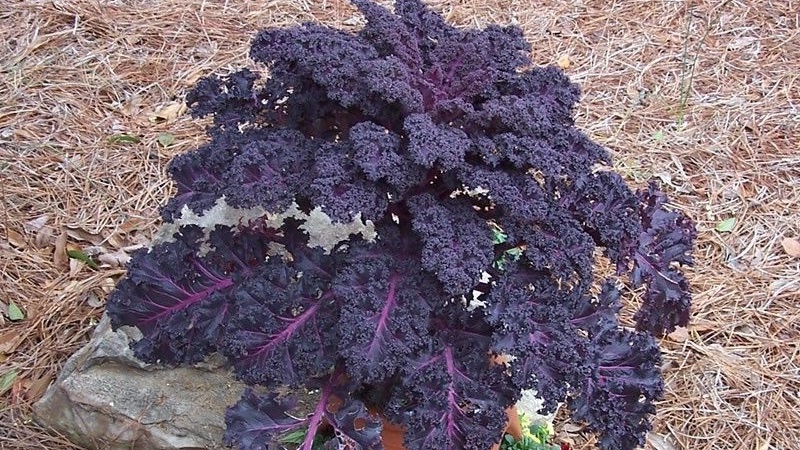
Predecessors
It is undesirable to plant a plant where its "relatives" were cultivated last season from the cruciferous family, since they have common pests and diseases. Do not plant after beets, carrots, radishes, rutabagas, radishes, daikon.
The best predecessors are any nightshade, legumes, pumpkin, herbs and grains.
Timing, scheme and landing rules
Hybrid seeds germinate already at + 5 ° C... Therefore, they begin to plant them in early or mid-April.
Landing scheme:
- Holes are made under the seeds at a distance of 45 cm, humus and wood ash are placed in them.
- Seeds are planted in rows, between which a gap of 50 cm is observed.
For seedlings, the planting scheme is similar.
Planting density and depth
The grains are buried by 1.5 cm, no more... Place 3-4 pieces in each hole. Then watered and sprinkled with soil.
Seedlings are planted to such a depth that is necessary for a comfortable placement of the root system and covered with earth to the first leaves. Planting density - 4-5 bushes per 1 m², interval - 60 cm.
Growing features
Crops are covered with foil to protect against cold snaps at night and return frosts. When sprouts appear (after 5-7 days), the cover is removed. Seedlings are thinned out - only one strongest sprout is left in each hole.
Seedlings are planted according to the scheme in the morning or in the evening, accompanying with abundant watering. For seedlings, they create a shelter from possible temperature extremes and sunlight. As soon as the seedlings get stronger, they are harvested.
Read also:
The nuances of care
Favorable temperature for the growth and development of Redbor cabbage - from +10 to + 20 ° C. They take care of the hybrid in much the same way as for other varieties of cabbage.
Watering mode
Kale is a moisture-loving plant, therefore it requires regular watering at the root... For this, circular grooves are made around the plants so that the water does not spread, but penetrates directly to the root system. In a dry season, the frequency of watering is increased and the soil is always moistened.
Important! Spraying the bushes is carried out only after sunset.
Loosening and hilling
After each watering, the aisles are loosened and slightly spud cabbage stalks, as necessary, get rid of weeds. Mulching the soil with a layer of straw or rotted sawdust reduces the number of loosening and irrigation.
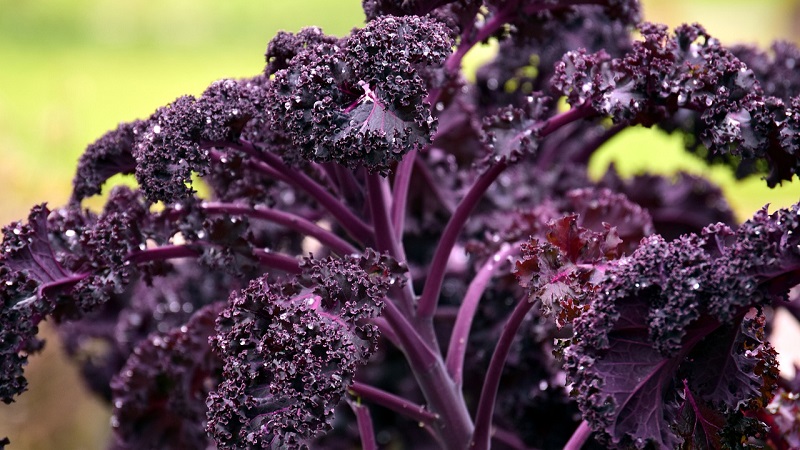
Top dressing
In order for the cabbage rosettes to develop well, they are fertilized twice: 12-14 days after germination, after 2 weeks the procedure is repeated. The approximate composition of the solution for a bucket of water:
- for the first application - 10 g of urea, 20 superphosphate and potassium chloride;
- the second feeding is increased by 1.5 times, 1 g of molybdenum and 3 g of borax are added to it.
Measures to increase the yield
Increasing the yield of collard greens largely depends on a correctly selected complex of agrotechnical measures carried out during the growing season of the crop. To get a rich harvest of the Redbor F1 hybrid, it is enough to prepare the site well for planting and water the plantings in a timely manner. In general, the hybrid is rather picky and builds up a large green mass of leaves until the very frost.
Disease and pest control
Although hybrids are characterized by resistance to many diseases (gray rot, keel) and pests (aphids, cabbage fly), in order to protect, they still carry out preventive measures:
- Loosen the soil regularly to increase aeration so that gray mold does not spread.
- Dust the plantings with ash or tobacco dust to scare away cruciferous fleas.
- Spray with infusion of onion peel, wormwood to destroy aphids.
Harvesting and storage
Cleaning is done in one of two ways:
- they cut off the side leaves, which are larger, - leave smaller leaves;
- the entire plant is cut off completely and stored in a cool place until processing.
When to collect
Growing leaves are harvested throughout the summer... The younger, the more tender and tasty they are. They are cut in the early morning when the leaves are saturated with moisture as much as possible.
As soon as in the process of growth the leaves begin to coarse and lose their taste, carry out the final harvest. The entire growing season lasts up to 180 days.
Features of storage and keeping quality of hybrid Redbor F1
At room temperature, cabbage is stored for no more than 2-3 days, then withers... In the refrigerator - maximum 7 days. The leaves are placed in a container of water, like a bouquet, and covered with a plastic bag on top.
Freezing helps preserve such a product for a long time.... The leaves are pre-washed and dried at room temperature, spreading on paper or cloth napkins. It is advisable to cut off the stems and veins, leaving only the leaf plate.
What can be the difficulties in growing
When growing cabbage in the shade and dense plantings, nitrates can form in the leaves... To reduce their number, biologics are used at all stages of culture growth, which increase immunity and reduce the content of nitrates.
Like many leaf crops, the f1 Redborough withers and turns yellow on hot summer days... To prevent such phenomena at noon, the plants are provided with light shading.
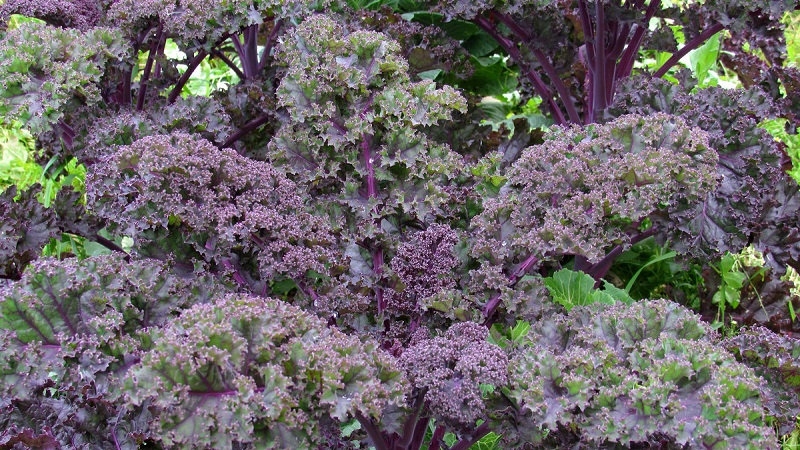
Redbor F1 cabbage dishes
It is most useful fresh, since under the influence of high temperatures, many of its valuable properties are lost.
Cabbage rolls
The leaves are poured over with boiling water, the thickenings are removed... Minced meat with semi-cooked rice is placed on a leaf and rolled into a tube. Then they are laid out in a mold, poured with mayonnaise and baked.
Salads
Various types of salads are prepared from kale, as it goes well with many vegetables and products: tomatoes, cucumbers, boiled meat, potatoes, eggs, garlic, basil, green onions, etc. Dressing for this salad is sour cream, mayonnaise, linseed, olive or pumpkin oil.
Crisps
Cabbage is cut into pieces (3 by 3 cm) and sent to a baking sheet covered with parchment... Sprinkle with pepper, salt and olive oil on top. A baking sheet is sent to an oven preheated to 100 ° C and dried until tender, leaving the door ajar.
Advice and feedback from experienced gardeners
Experienced gardeners who have been growing Redbor F1 cabbage hybrid for more than one year, it is advised to stock up on dried leaves of a plant for the winter, in which absolutely everything is preserved useful properties and taste of fresh vegetables.In this form, they are successfully used for the preparation of first and second courses. Both frozen and dried, the product is well stored throughout the year.
Evgeny, Saratov: “Last year I didn’t dare, but still I planted Redbor F1 cabbage in September and was satisfied. I managed to harvest before frost and provided myself with vitamins for the whole winter. Plus, the cabbage did not suffer from diseases and pests, and in the spring, young leaves can be eaten in May ".
Valentina, Volgograd region: “Originally planted Redbor F1 for beauty in the yard. And now it suits that the cabbage harvest can be harvested at least every day, breaking off the lower leaves, and so on until winter. Plants take on the appearance of small palms - a tall, bare trunk and a bunch of leaves on the top of the head. Try to plant, suddenly you like it ".
Conclusion
Redbor F1 is a vegetable that will not only feed, but also become a decoration of the summer cottage. Vitamins and minerals in the composition of the plant protect against many diseases, and excellent taste is successfully used in the cuisines of various countries. Knowing the peculiarities of agricultural techniques, even a novice gardener will grow such a useful and bizarre-looking cabbage.